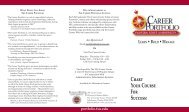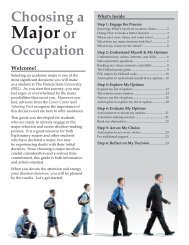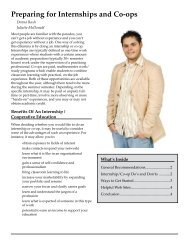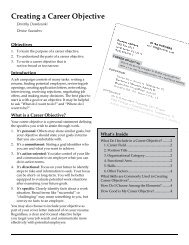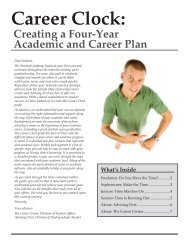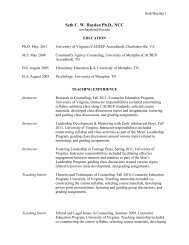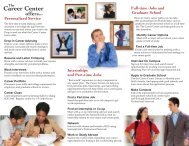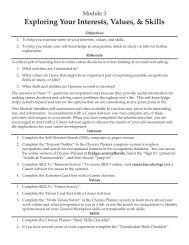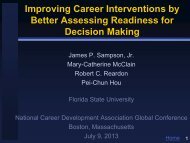Holland's Theory in a Post-Modern World: - The Career Center ...
Holland's Theory in a Post-Modern World: - The Career Center ...
Holland's Theory in a Post-Modern World: - The Career Center ...
You also want an ePaper? Increase the reach of your titles
YUMPU automatically turns print PDFs into web optimized ePapers that Google loves.
Holland’s <strong><strong>The</strong>ory</strong> 1849,450 comprised of five ethnic groups <strong>in</strong> relation to gender, Day and Rounds found a markedlysimilar underly<strong>in</strong>g <strong>in</strong>terest structure. <strong>The</strong>y concluded that the structure of m<strong>in</strong>ority vocational<strong>in</strong>terests seems to be well represented by Holland’s RIASEC model, and <strong>in</strong>struments based onsuch theories have validity for diverse groups <strong>in</strong> the United States. “Furthermore, the commonstructure of vocational <strong>in</strong>terests is theoretically related to McCrae and Costa's (1997) claim ofpersonality structure as a universal. If vocational preferences are <strong>in</strong>deed manifestations ofpersonality, then the two claims are one” (Day & Rounds, 1998, p. 735). Of course, persons whodiffer greatly from average <strong>in</strong> any characteristic, i.e., very poor or very rich, very slow or verysmart, a special talent or genetic characteristic, may be outside the range of what the typologyseeks to help us understand or expla<strong>in</strong> (Holland, 1997).Holland-Based AssessmentsStead and Watson (1998) posited that translations of theories and <strong>in</strong>struments orig<strong>in</strong>at<strong>in</strong>g<strong>in</strong> the U.S. for the use <strong>in</strong> other cultural sett<strong>in</strong>gs often do not account for the context <strong>in</strong> which theywill be used. Not only must f<strong>in</strong>d<strong>in</strong>gs from research with diverse populations be <strong>in</strong>corporated, butalso issues pert<strong>in</strong>ent to liv<strong>in</strong>g <strong>in</strong> those places must be addressed. Although Holland’s theory andassociated measures have been translated <strong>in</strong>to numerous languages and have shown to be reliabletranslations (e.g., du Toit & de Bru<strong>in</strong>, 2002; Tracey et al., 1997), some hold they have notaccounted for the culture context <strong>in</strong> which these measures will be used (e.g., Tang, 2001). Weexam<strong>in</strong>ed exist<strong>in</strong>g evidence for the applicability of Holland’s measures worldwide, concentrat<strong>in</strong>gon what has been found s<strong>in</strong>ce the meta-analytic study by Rounds and Tracey (1996).In the United States, multicultural research has focused on the applicability of Holland’stheory with different ethnic m<strong>in</strong>orities liv<strong>in</strong>g with<strong>in</strong> the U.S. <strong>The</strong> results have been relativelypositive with most studies confirm<strong>in</strong>g that Holland’s RIASEC types fit well with <strong>in</strong>dividuals of



